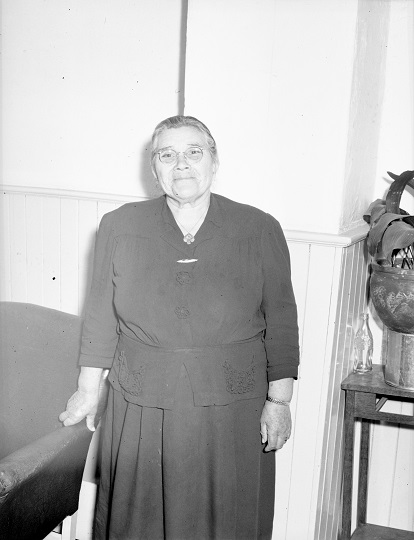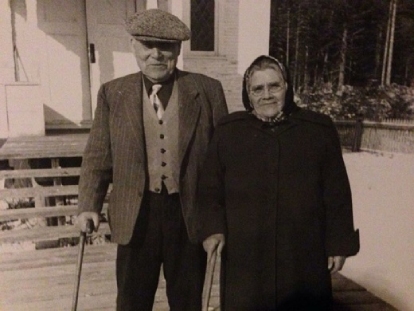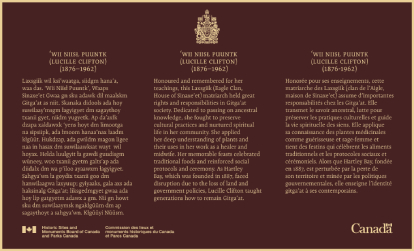‘Wii Niisł Puuntk (Lucille Clifton) National Historic Person (1876-1962)
‘Wii Niisł Puuntk (Lucille Clifton) was designated as a national historic person in 2016.
Historical importance: Former Laxsgiik (Eagle Clan) leader, she is an outstanding example of a centuries-old role held by prominent Gitga'at (Tsimshian) women in this matrilineal society, held traditional knowledge and passed on cultural practices.
Commemorative plaque: Hartley Bay Cultural Centre, in Hartley Bay (Gitga'at First Nation), British ColumbiaFootnote 1
‘Wii Niisł Puuntk (Lucille Clifton) (1876-1962)
Honoured and remembered for her teachings, this Laxsgiik (Eagle Clan, House of Sinaxe’et) matriarch held great rights and responsibilities in Gitga'at society. Dedicated to passing on ancestral knowledge, she fought to preserve cultural practices and nurtured spiritual life in her community. She applied her deep understanding of plants and their uses in her work as a healer and midwife. Her memorable feasts celebrated traditional foods and reinforced social protocols and ceremony. As Hartley Bay, which was founded in 1887, faced disruption due to the loss of land and government policies, Lucille Clifton taught generations how to remain Gitga'at.
‘Wii Niisł Puuntk (Lucille Clifton) (1876-1962)
Laxsgiik wil ksi’waatga, siidgm hana’a, waa das. ‘Wii Niisł Puuntk’, Waaps Sinaxe’et Gwaa gn sku adawk dił maalskm Gitga’at as niit. Skanaka didools ada hoy suwilaay’msgm łagyigyet dm sagaythoy txanii gyet, niidm yugyetk. Ap da’axłk dzapa xaldawxk ‘yens hoyt dm limootga na sipsiipk, ada łmoom hanaa’nax łaadm kłgüüt. Hukdzap, ada gwildm magon ligee naa in hasax dm suwilaawksat wayt wil hoyax. Helda luulgyit ła gawdi guudisgm wüneey, woo txanii gyetm galts’ap ada diidalx dm wa p’iloo ayaawxm łagyigyet. Sahgya’wn ła goydix txanii goo dm hanwilaagwa laxyuup; gyiyaaks, gala axs ada haksinalg Gitga’at; liksgedmgyet gwaa ada hoy lip gatgyetm adawx a gm. Nii gn howt sku dm suwilaaymsk ngakłgüüm dm ap sagaythoyt a sahgya’wn. Kłgüüyi Nüüsm.

© Courtesy of the Prince Rupert City & Regional Archives & Museum of Northern British Columbia, Wrathall collection / JRW2208
‘Wii Niisł Puuntk (Lucille Clifton) (1876-1962)
Honoured and remembered for her teachings, Wii Niisł Puuntk (Lucille Clifton) was the Laxsgiik (Eagle Clan, House of Sinaxe’et) matriarch of the Gitga’at of Hartley Bay for over half a century, beginning around 1890. At a time when her community faced broad cultural disruption, she was one of the few who still held ancestral knowledge. Recognizing its intrinsic value for the future, Clifton dedicated her life to passing on cultural practices such as social protocols and ceremonial ways, as well as Indigenous and non-Indigenous health skills, including midwifery. She is especially remembered for her knowledge of plants from the sea and from the land, their harvesting and processing into food and medicine, and their manufacture into items of everyday use. Her teaching helped to preserve cultural practices and she taught generations how to remain Gitga’at.

© Courtesy of Teresa Robinson for Gitga'at First Nation / Parks Canada
Clifton is an outstanding example of a centuries-old role played by prominent Gitga’at women in this matrilineal society. She belonged to the Gitga’at people of Hartley Bay, one of 14 individual First Nations that form the broader Tsimshian of the northwestern corner of British Columbia. She became the matriarch of the Laxsgiik (Eagle Clan, House of Sinaxe’et) of Hartley Bay, making her the highest-ranking female in the clan. Her primary responsibilities were to manage the territory of the House of Sinaxe’et, to provide for its members, and to meet the social and ceremonial responsibilities of the house with respect to the clan, but also to other houses of the Gitga’at.
For over 50 years, Clifton carried out the responsibilities of being the matriarch while also guiding the Gitga’at through a period of broad and traumatic change. By the 1880s, culture loss had been extensive throughout Tsimshian territory. Government laws and the adoption of Christianity changed ancient links to secret societies and shamanism, created substantial language losses, and outlawed ceremonies and feasts such as potlatches, all of which were central to Tsimshian social framework and community relationships. Land losses were significant due to European encroachment and these culminated in the creation of reserve lands. As a result, access was lost to a number of important traditional resource areas, thus changing the Gitga’at relationship with the land.
Within this context, Clifton passed on her multi-faceted and vast set of ancestral knowledge. She left a lasting legacy of teaching traditional social protocols and the celebration of foods through community feasting. A midwife and healer, she was also trained in non-Indigenous hygiene and disease prevention at a time when European diseases still had a devastating effect on the Tsimshian. She also played an important role in nurturing the spiritual life of Hartley Bay, having adapted Protestant Christianity to Gitga’at culture. Clifton continues to stand out in memory as a leader, teacher and mentor in her community of Hartley Bay.
Backgrounder last update: 2018-02-26
The National Program of Historical Commemoration relies on the participation of Canadians in the identification of places, events and persons of national historic significance. Any member of the public can nominate a topic for consideration by the Historic Sites and Monuments Board of Canada.
- Date modified :
